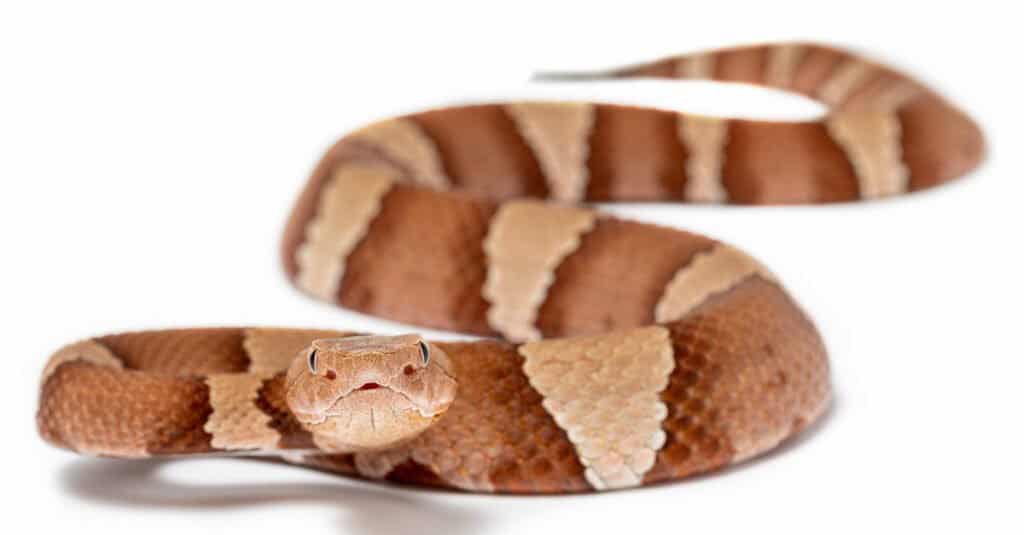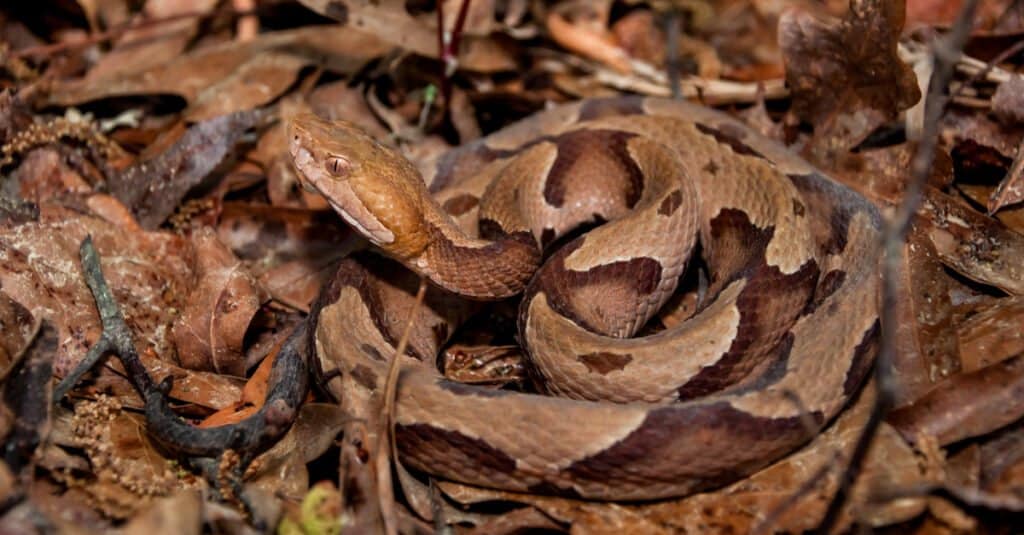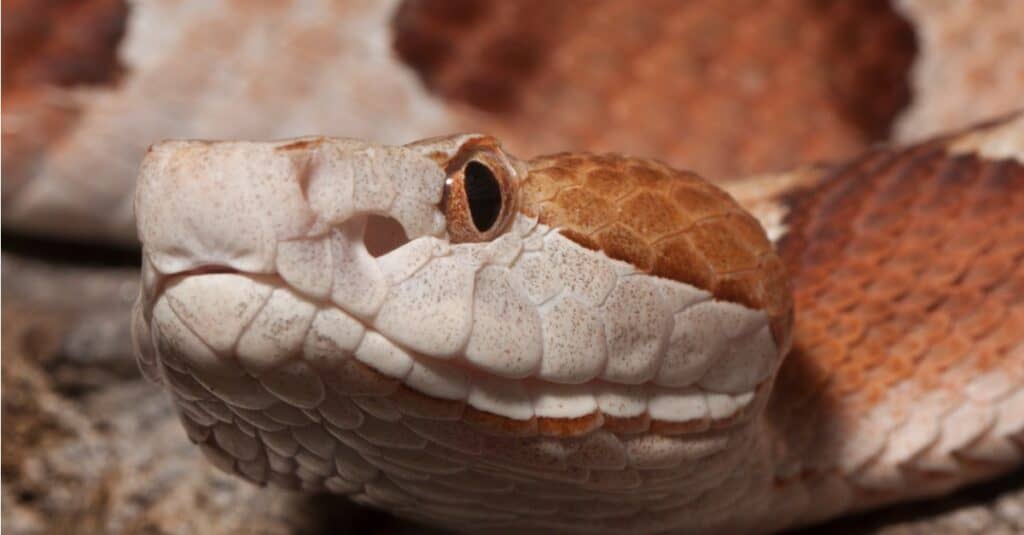Copperheads are some of the most common snakes across the eastern United States. These venomous snakes are quite beautiful but can also pack quite the punch if you happen to get bit.
There are two copperhead species (more on this below), with the northern copperhead being the most widespread. If you live from Nebraska to the eastern coast, you have likely encountered one of these snakes before!
Today, we are going to explore copperhead snake bites and learn just how deadly they are. By the end, you should know a bit more about the venom of these snakes, plus have some guidance on what to do if you should encounter them.
Let’s get started!
How Dangerous are Copperhead Snake Bites?

Copperhead bites are rarely fatal and can be treated with modern antivenom.
©Scott Delony/Shutterstock.com
Copperheads are some of the more common venomous snakes that can be found in the US. With their venomous nature and wide range, bites are bound to happen. If you get bit, however, just how dangerous are they?
Copperhead Venom

Copperhead venom is hemotoxic and damages the tissue around the injection site.
©Jay Ondreicka/Shutterstock.com
The venom of a copperhead is known as “hemotoxic”. Hemotoxic venom is characterized by tissue damage, swelling, necrosis, and damage to the circulatory system. While this may seem terrifying, it is all relatively localized.
Although it may be painful, copperhead bites are only mildly dangerous to most people. The venom of a copperhead is actually less dangerous than most pit vipers, and of the 2,920 people bitten annually by copperheads, just .01% result in fatalities. For reference, the eastern diamondback rattlesnake injects up to 1,000 mg per bite and has a 20-40% mortality rate left untreated.
Aggression and defensiveness
While most humans consider all snakes to be “out to get them”, this is actually far from the truth. Most snakes want to avoid humans, especially the copperhead. In fact, most copperheads will give a warning bite to an encroaching human. These warning bites don’t inject venom and are known as a “dry bite,” requiring no antivenom administration.
With the reluctance that copperheads have to bite, the likelihood of receiving a dry bite if they do strike, and the relatively low toxicity of their venom, these snakes are among the least dangerous venomous snakes in the US.
What Do You Do if Bitten by a Copperhead?

Copperhead bites are often dry, but emergency services should always be contacted in case of a reaction.
©iStock.com/Mark Kostich
If you happen to see a copperhead, your best option is to leave it alone. They usually try to remain unseen and don’t want interactions with a big, scary human. Still, accidents happen, and most human bites occur when the human doesn’t see the snake and is moving or reaching into the snake’s space.
If you are bitten by a copperhead, the first thing you should do is seek medical attention. Although it is possible that the bite was dry, it is still wise to seek help in the case that a reaction develops. If the wound doesn’t swell or hurt any more than a standard puncture wound, it’s likely that it was dry.
In rare cases, some people may be allergic to copperhead venom. Similar to a bee allergy, these reactions can be fatal, and fast treatment is essential.
After emergency services are called, follow these steps:
- note the time of the bite
- remove watches and rings (in case of swelling)
- wash the area with soap and water
- keep the wound lower than the heart
- don’t try to “suck out the venom” and don’t apply a tourniquet
In most cases, people bitten by a copperhead are back to normal within 2-4 weeks.
What is the Most Venomous Snake?
The inland or western taipan (Oxyuranus microlepidotus) holds the title of the world’s most venomous snake. This snake, indigenous to Australia, possesses the most lethal venom.
Additionally, the venom of the inland taipan stands as the most potent venom among all land snakes worldwide. To illustrate, it is approximately 50 times more toxic than the venom produced by the Indian cobra.
Furthermore, saw-scaled vipers, in terms of global statistics, may be responsible for the highest number of snakebite-related fatalities. The Indian saw-scaled viper is particularly hazardous due to its diminutive size, envenomating over 75% of its bite victims, and displaying a notably high level of aggression.
The photo featured at the top of this post is © Scott Delony/Shutterstock.com
Discover the "Monster" Snake 5X Bigger than an Anaconda
Every day A-Z Animals sends out some of the most incredible facts in the world from our free newsletter. Want to discover the 10 most beautiful snakes in the world, a "snake island" where you're never more than 3 feet from danger, or a "monster" snake 5X larger than an anaconda? Then sign up right now and you'll start receiving our daily newsletter absolutely free.
FAQs (Frequently Asked Questions)
What states are copperhead bites most common?
The state with the most reported copperhead bites per capita is North Carolina. After North Carolina, they’re most common in West Virginia, Arkansas, Oklahoma, Virginia, and Texas. The rate of copperhead bites is more than three times as high in North Carolina compared to Virginia or Texas.
How many species of copperheads are there?
There’s an ongoing debate in the scientific community around Copperhead species. Previously, there were five recognized subspecies. However, recent gene analysis shows that there are two distinct copperhead species: the eastern copperhead and the broad-banded copperhead. Broad-banded copperheads live in Texas, Oklahoma, Kansas, and Mexico while eastern copperheads across the eastern seaboard.
Thank you for reading! Have some feedback for us? Contact the AZ Animals editorial team.






